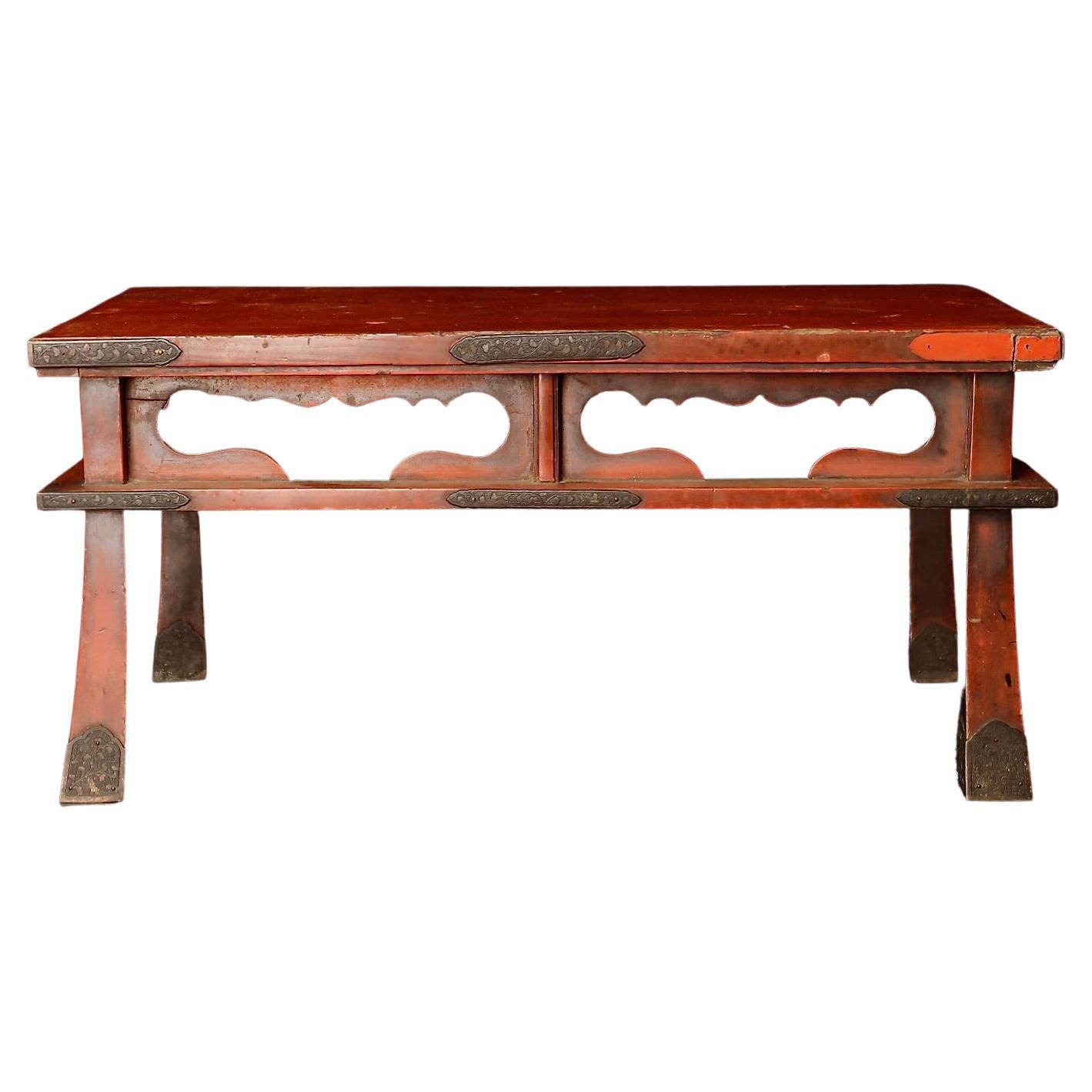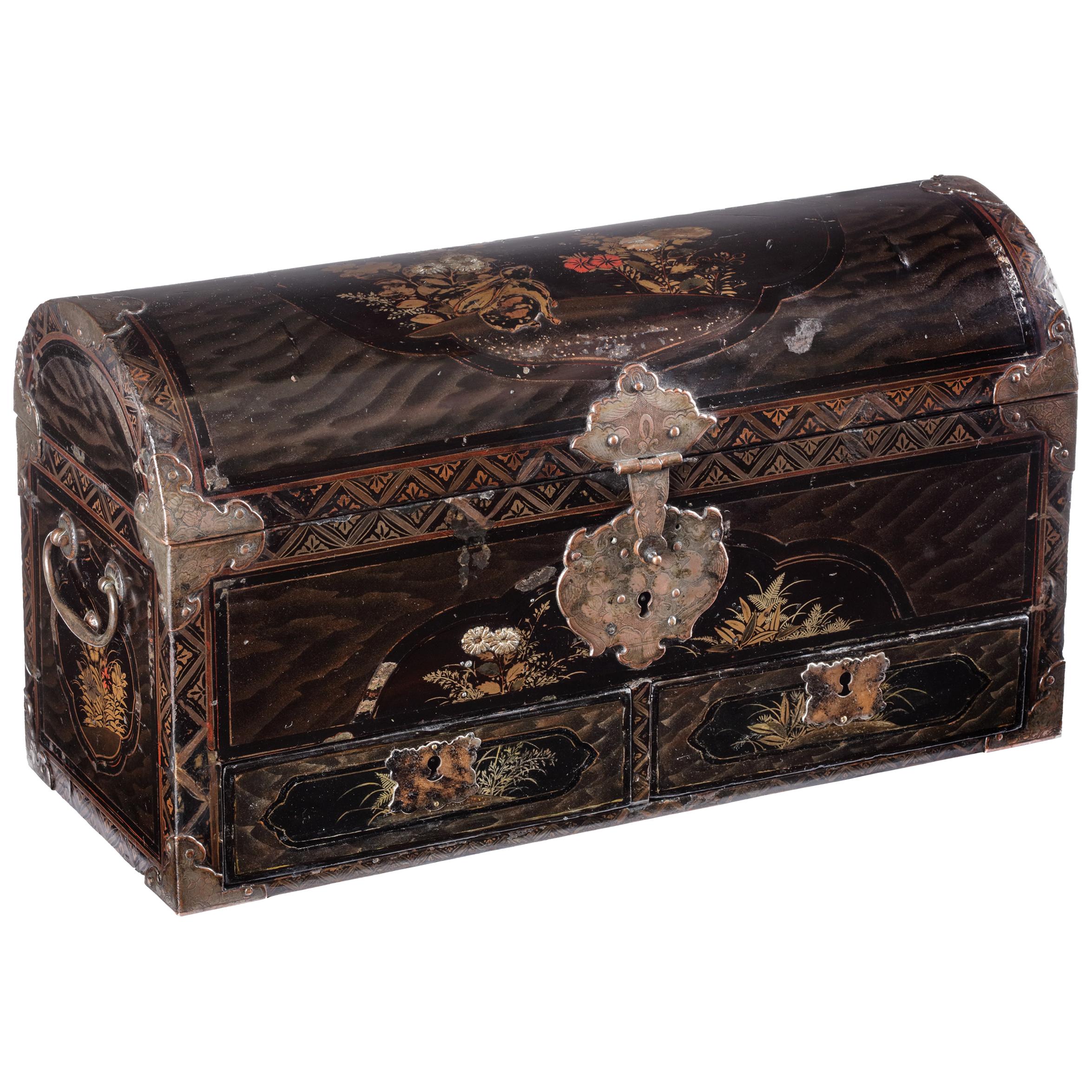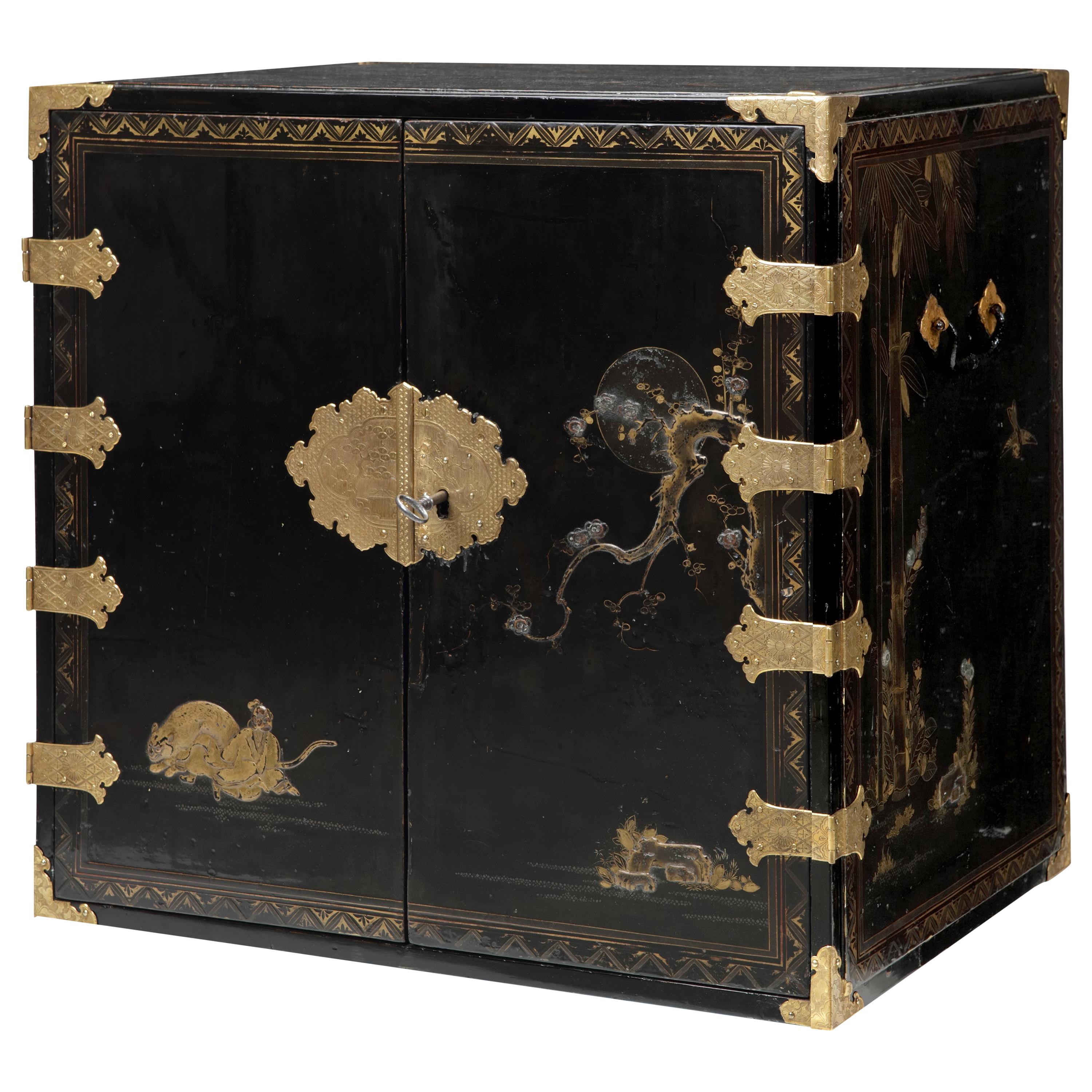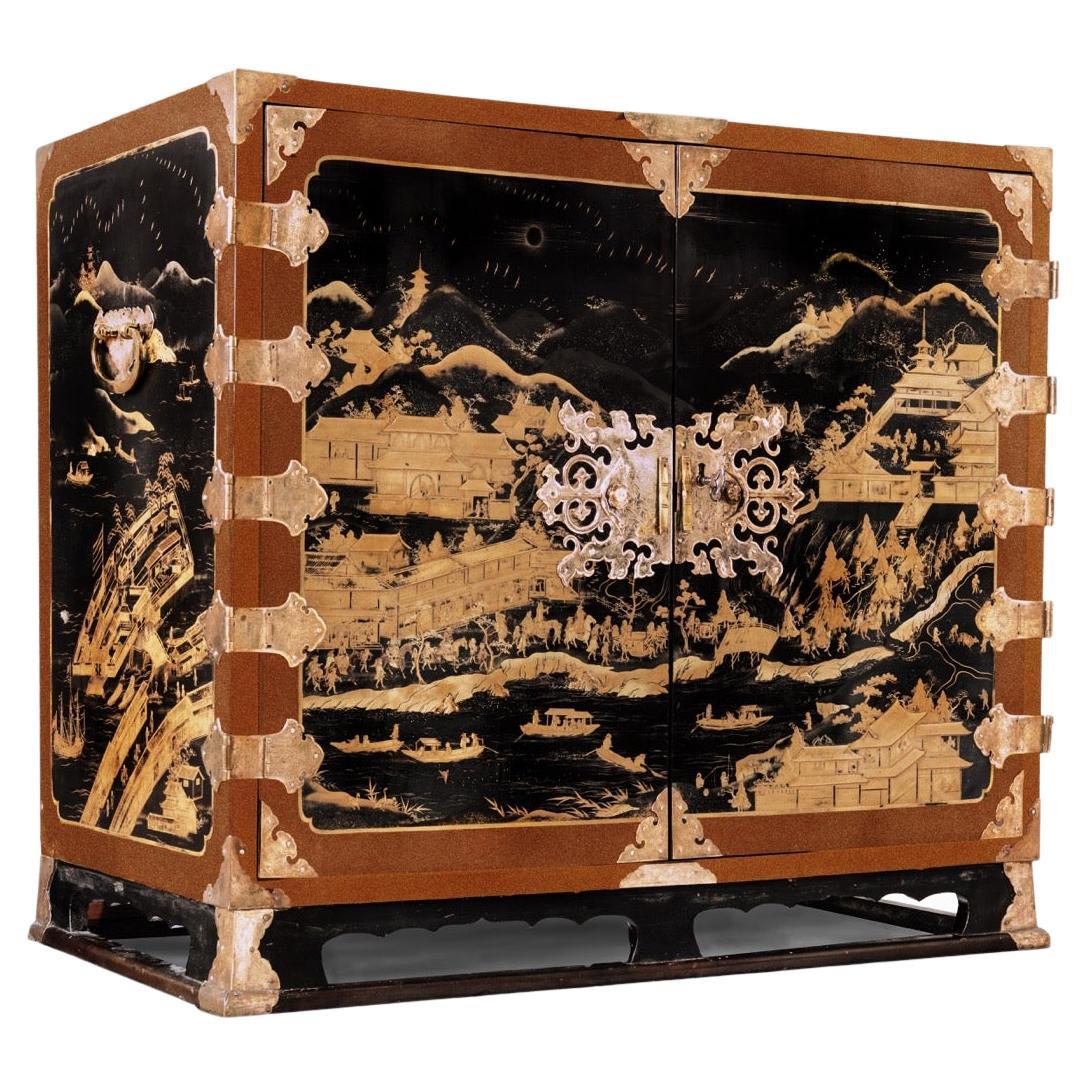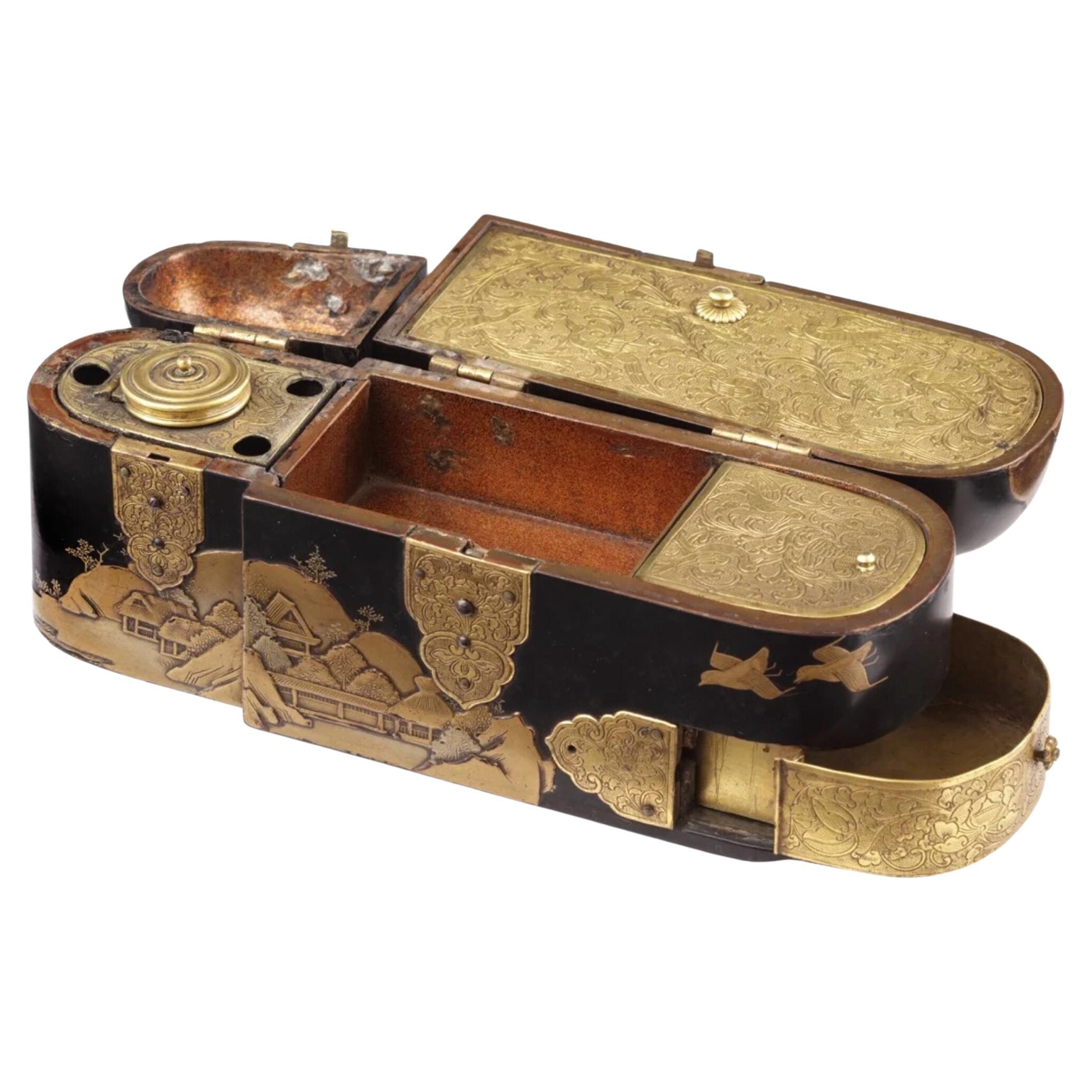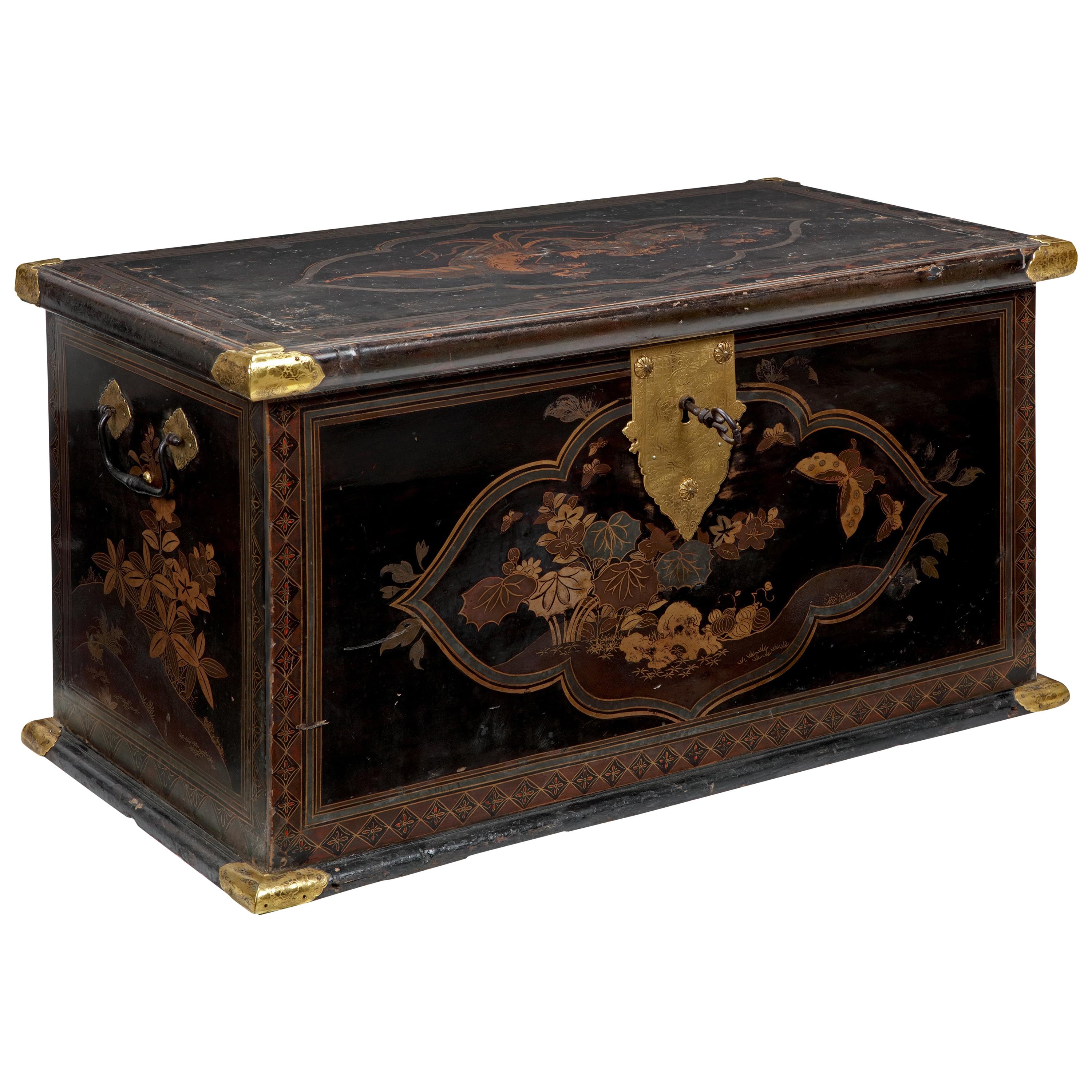Items Similar to Japanese Lacquered Basin with Ear-Shaped Handles 'Mimidarai', 17th Century
Want more images or videos?
Request additional images or videos from the seller
1 of 8
Japanese Lacquered Basin with Ear-Shaped Handles 'Mimidarai', 17th Century
About the Item
Wooden basin with ear-shaped handles decorated with hiramaki-e lacquer and gold and silver kirigane on a nashi-ji ground.
The large and thick antique wooden basin is completely lacquered in nashiji gold, with cranes flying among pines, bamboo and orange trees. The overall design and the gilt metal fittings include also the umebachi family crest, in the variation used by the Maeda clan. The designs on the lacquered surface and on the fittings are both typical of the early part of the Edo period (1615-1867).
The mimidarai, literally “eared basin” due to the handles’ shape, was part of a larger teeth blackening set. Teeth blackening (ohaguro) using black ink was a common practice in Japan among women of wealthy families since ancient times. For a while, it became a trend also for men, but during the Edo period, it was again popular only among the female population, where it was a sign of marriage for women of all social classes.
Featured in this antique heishi are four longevity symbols that express the universal wish for a long, healthy life.
The pine tree is one of the most common symbols of longevity in East Asia. Because it remains green even in the harshest winters, it stands for resilience, endurance, and strength against adversity.
Cranes live a long time, some species as long as eighty years. In some Asian folktales, they are said to live as long as five hundred years. Cranes mate for life, and therefore symbolize harmony, a wish for a long marriage, and respect for one’s parents and ancestors.
Turtles are noted for their long lifespan. In addition, with their dome-shaped upper shell, flat lower shell, and legs in the four corners of their bodies, they were early emblems of the universe and the cardinal directions.
Bamboo is one of the most versatile and abundant materials in East Asia, eaten by both humans and animals and used to make everything from houses to paper. It remains green throughout the Four Seasons and therefore symbolizes long life. Because it bends rather than breaks, bamboo also represents resilience, and its simple shape, humility. According to Confucian ideology, bamboo possesses the qualities of a great scholar: humility, uprightness, the flexibility of mind, and grace.
- Dimensions:Height: 5.91 in (15 cm)Width: 10.63 in (27 cm)Depth: 12.6 in (32 cm)
- Materials and Techniques:Wood,Lacquered
- Place of Origin:
- Period:
- Date of Manufacture:circa 1650
- Condition:
- Seller Location:Milano, IT
- Reference Number:
About the Seller
5.0
Recognized Seller
These prestigious sellers are industry leaders and represent the highest echelon for item quality and design.
Established in 2005
1stDibs seller since 2018
10 sales on 1stDibs
Typical response time: 1 hour
- ShippingRetrieving quote...Ships From: Milano, Italy
- Return PolicyA return for this item may be initiated within 7 days of delivery.
More From This SellerView All
- Japanese Negoro Lacquer Tray 'Oshiki', 16th CenturyLocated in Milano, ITAntique Negoro lacquer wares were produced at the Negoro-ji temple complex in Izumi Province. The red layers of lacquer on Negoro wares are intended to ...Category
Antique 16th Century Japanese Lacquer
MaterialsWood
- Five-Case Inrō 19th Century Signed Kajikawa Saku Japanese Lacquer BoxLocated in Milano, ITSigned: “Kajikawa saku” and with a red pot seal Height: 3 1/8in (7.9cm) Provenance: Michael Tomkinson Collection Leonard Haber Collection Literature: Michael Tomkinson, A Japanese Collection, London: George Allen, 1898, no. 300 Each case with slightly recessed joints and with different grounds, including kinji, nashiji, togidashi maki-e and gyobu-nashiji, on the obverse decorated with a treasure ship laden with the attributes of the Seven Gods...Category
Antique 19th Century Japanese Lacquer
MaterialsWood, Lacquer
- Inro by Mochizuki Hanzan (1743-90?) Edo Period, 18th centuryLocated in Milano, ITMochizuki Hanzan (1743-90?) Edo Period, 18th century Decorated with inlaid colored ceramic with a stag and maple leaves Height: 8.4 cm Sealed Hanzan Mochizuki Hanzan (1743-90?...Category
Antique 18th Century Japanese Lacquer
MaterialsWood
- Tomizo Saratani '1949', Natural Stone with Squid and ShrimpsLocated in Milano, ITUrushi lacquer on stone Measures: 12.3 by 9.5 by 6.5 cm Tomizo Saratani was born in Kyoto and has spent his life working on traditional japa...Category
2010s Japanese Lacquer
MaterialsStone
- Late 17th Early 18th Century Nabeshima Japanese Porcelain Plate Fruit DesignLocated in Milano, ITDish with karatuuri (melon) design Late 17th-early 18th century Porcelain decorated with cobalt blu underglaze and red fruits Diameter 15.2 cm Nabeshima ware was made at Okawachi near Arita in Kyushu under the authority of the Nabeshima clan. The feudal lords of Nabeshima were so proud of their technological skill, that throughout the Edo period (1615-1867) they gave porcelain (and swords) as presents to the lords of other provinces. Most of Nabeshima porcelain...Category
Antique Late 17th Century Japanese Ceramics
MaterialsPorcelain
- Kogo in the Shape of a DeerLocated in Milano, ITHiramaki-e lacquer, nashiji and fundame Edo period, 19th century Length: 10.5 cm, height: 6.5 cm Since the Heian period, The theme of deer and autumn plants has been ut...Category
Antique 19th Century Japanese Lacquer
MaterialsWood
You May Also Like
- 17th Century Japanese Negoro Style Lacquered StandLocated in Fukuoka, JPA Rare Negoro Lacquer Buddhist Stand This rare and historic Negoro lacquer Buddhist stand is a beautiful example of Japanese craftsmanship. It is made of wood with Negoro-style lacq...Category
Antique 17th Century Japanese Lacquer
MaterialsWood, Lacquer
- Fine Japanese Namban Lacquer Jewelry Casket, 17th CenturyLocated in Amsterdam, NLJapanese Namban lacquer transition-style coffer with two drawers Kyoto/Nagasaki, circa 1650 The cartouches with gilt and red decorations of leaves...Category
Antique 17th Century Japanese Edo Lacquer
MaterialsCypress
- Rare Charming 17th Century Japanese Lacquer Cabinet with Gilt-Bronze MountsLocated in Amsterdam, NLA fine Japanese pictoral style lacquer cabinet with gilt-metal mounts Kyoto, Edo period, 1670-1690 Decorated in Japanese relief lacquer work, black lacquer ground decorated...Category
Antique Late 17th Century Japanese Furniture
MaterialsBronze
- 17th Century Japanese Export Lacquer Cabinet with Depiction the Dutch TradepostLocated in Amsterdam, NLA highly important Japanese export lacquer cabinet with depiction of the Dutch East India Company tradepost Deshima and the annual Dutch delegation on its way to the Shogun in Edo Edo period, circa 1660-1680 H. 88 x W. 100.5 x D. 54 cm This cabinet includes a later European japanned stand, but also a modern powder-coated steel frame. The latter can be designed and added to your specific needs. The sides and front of the rectangular two-door cabinet are embellished in gold and silver hiramaki-e and takamaki-e on a black roiro lacquer ground with a continuous design. The two doors depict a long procession of numerous figures travelling on foot and horseback along buildings and a pagoda into a mountainous landscape. This is the annual court journey, Hofreis, of the Dutch from Nagasaki to the Shogun’s court in Edo. Three horseback riders are dressed as Dutch merchants and a fourth figure, probably het Opperhoofd, is seen inside a palanquin, norimon. Just about to cross the bridge, two men are carrying a cabinet like the present one. Many Japanese figures on either side of the procession are engaged in various activities; some play musical instruments on board of small boats, others are fishing; figures inside buildings are depicted playing go, and farmers are tending to their rice paddocks. The upper part of the right door shows a large mansion, probably the local daimyo’s castle, with men kneeling before a man in the central courtyard. The court journey fits in with the foreign policy of the shogunate which accorded a role to the VOC alongside China, Korea, and the Ryukyu Islands who also had to pay tribute. However, the VOC employees were traders, having low status in Japan’s social hierarchy, and they were received with less deference than were the state embassies from Korea and the Ryukyu Islands. Nevertheless, the contacts with the Dutch were a welcome source of information to the Shogun about Europe and European science and technology. The left side of the cabinet depicts, in mirror image, a rare view of the artificial fan-shaped Deshima Island, the trading post for the Dutch in Japan. The island, where the Dutch flag flies, is surrounded by small Japanese boats and an anchored three-masted fluyt (cargo ship), flying Dutch flags, with on the stern the VOC monogram. On the bottom right a busy street of Nagasaki is shown, bordered by shops and leading up to the stone bridge. On the island the trees are beautifully painted, two cows can be seen, and the flagpole, all in very fine detail. Dutchmen and enslaved Malay are visible outside the buildings and two Japanese figures, probably guards, sit in a small hut in the centre. A maximum of fifteen to twenty Dutchmen lived on the island at any time and soldiers or women were not allowed. Restrictions on Deshima were tight, and the merchants were only allowed to leave the island by special permission. The Opperhoofd had to be replaced every year, and each new Opperhoofd had to make a court journey to pay tribute, present gifts, and to obtain permission to Margaret Barclay eep on trading. In the distance, many birds fly above the hills and a four-story pagoda can be seen. The right side of the cabinet is painted with other horse riders and their retinue journeying through mountains. The pair of doors to the front open to reveal ten rectangular drawers. The drawers are decorated with scenes of birds in flight and landscapes with trees and plants. The reverse of the left door with two thatched buildings, one with a ladder, underneath a camelia tree with large blooms; the right door with a three-story pagoda nestled among trees and both doors with a flying phoenix, ho-oo bird. The cabinet, with elaborately engraved gilt copper mounts, hinges, lock plates and brass handles, is raised on an 18th-century English japanned wood stand. A pair of large cabinets...Category
Antique 17th Century Japanese Edo Lacquer
MaterialsCopper, Gold
- Rare 17th Century Japanese Export Lacquer Medical Instrument BoxLocated in Amsterdam, NLA rare Japanese export lacquer medical instrument box Edo-period, 1650-1700 L. 19 x W. 6 x H. 8.5 cm This unconventionally shaped lacquer b...Category
Antique 17th Century Japanese Edo Lacquer
MaterialsGold
- Large Royal Early 17th Century Japanese Lacquer Chest with Gilt-Bronze MountsLocated in Amsterdam, NLA large Japanese transitional lacquer chest with gilt-metal mounts Edo period, early 17th century The rectangular chest with flat hinged lid decorated in gold, silver, and red ...Category
Antique Early 17th Century Japanese Blanket Chests
MaterialsBronze
Recently Viewed
View AllMore Ways To Browse
Lacquer Brown
Century Black Lacquer Furniture
Century Furniture Black Lacquer
Antique Handles For Furniture
Lacquer On Wood
Black Lacquer Design
Legs And Handles
Lacquer Signed
Black Gold Lacquer
Gold And Black Lacquer
Lacquer Furniture Green
Lacquered Furniture Green
Lacquered Japan
Lacquer Japan
Japanese Lacquered
Lacquered Wood Gilt
Gilt Lacquer Wood
Lacquered Bamboo
